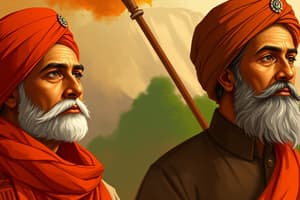Podcast
Questions and Answers
How is acceleration calculated?
How is acceleration calculated?
- Dividing time by change in velocity
- Dividing velocity by time
- Dividing change in velocity by time (correct)
- Dividing distance by time
Why is acceleration considered a vector quantity?
Why is acceleration considered a vector quantity?
- Because it has direction but no magnitude
- Because it has magnitude but no direction
- Because it has both magnitude and direction (correct)
- Because it varies with distance
What is the definition of velocity?
What is the definition of velocity?
- The rate at which an object changes its temperature
- The rate at which an object changes its color
- The rate at which an object changes its position (correct)
- The rate at which an object changes its shape
What does uniform motion refer to?
What does uniform motion refer to?
How is acceleration defined?
How is acceleration defined?
What is the characteristic of an object in uniform motion?
What is the characteristic of an object in uniform motion?
What type of quantity is velocity?
What type of quantity is velocity?
How is displacement related to velocity?
How is displacement related to velocity?
Study Notes
Motion and Acceleration
- Acceleration is calculated as the rate of change of velocity, often expressed as Δv / Δt, where Δv is the change in velocity and Δt is the time over which the change occurs.
- Acceleration is considered a vector quantity because it has both magnitude (amount of movement) and direction, which means it can be described in terms of its size and direction.
Velocity
- Velocity is defined as the rate of change of an object's position with respect to time, often expressed as displacement per unit time.
- Velocity is a vector quantity, having both magnitude (speed) and direction.
Uniform Motion
- Uniform motion refers to the motion of an object at a constant velocity, meaning the object moves at a constant speed in a straight line.
- The characteristic of an object in uniform motion is that it maintains a constant velocity, with no acceleration or deceleration.
Displacement and Velocity
- Displacement is related to velocity in that it is the total distance traveled by an object in a specific direction, whereas velocity is the rate of change of that displacement.
Studying That Suits You
Use AI to generate personalized quizzes and flashcards to suit your learning preferences.
Description
Test your knowledge about the aspirations and dreams of Bhagat Singh, a prominent figure in the Indian independence movement, with this quiz.


